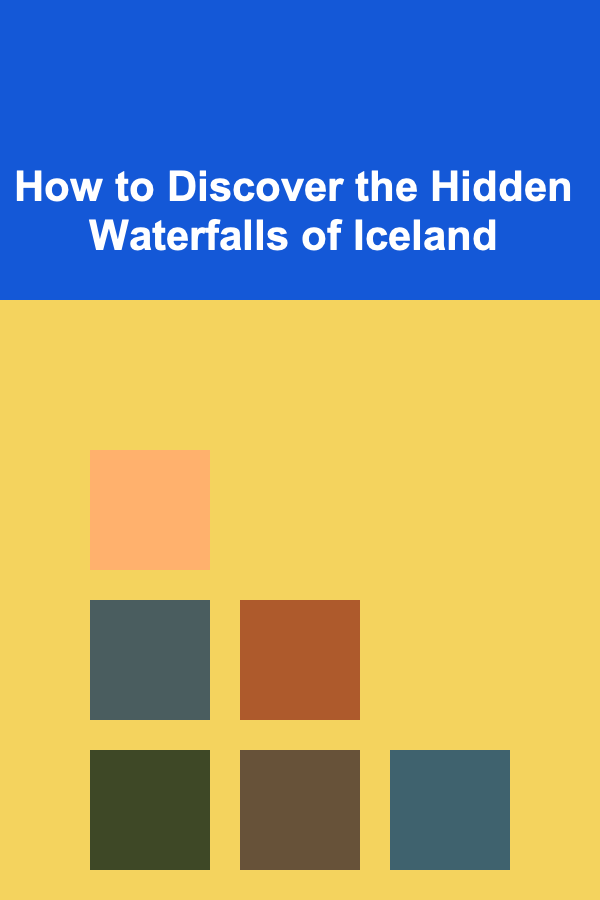
How to Discover the Hidden Waterfalls of Iceland
ebook include PDF & Audio bundle (Micro Guide)
$12.99$11.99
Limited Time Offer! Order within the next:

Iceland, known for its ethereal beauty and surreal landscapes, is a country where nature reigns supreme. The island is home to numerous majestic waterfalls, many of which are visible along well-trodden tourist paths. However, hidden beneath the surface of this captivating country are countless lesser-known waterfalls, tucked away in remote corners or nestled in rugged terrain, waiting to be discovered. These hidden gems often offer a quieter, more intimate experience with nature, far from the crowded attractions. In this article, we will explore how to find and enjoy the hidden waterfalls of Iceland, revealing the best techniques, strategies, and the rewards of uncovering these natural wonders.
Why Iceland's Waterfalls Are So Unique
Before diving into the discovery of hidden waterfalls, it's important to understand why Iceland is so rich in these stunning cascades. Iceland is a land of contrasts and extreme geological activity, sitting at the junction of two tectonic plates---the North American and the Eurasian plates. This seismic activity, along with volcanic eruptions and glacial meltwater, contributes to the formation of Iceland's distinctive landscape.
Waterfalls in Iceland are often born from rivers that flow from glaciers, volcanic craters, or geothermal springs. The landscape's ruggedness, with steep cliffs and deep ravines, makes it the perfect canvas for these natural masterpieces. What makes Iceland's waterfalls even more special is their diversity---ranging from tall, dramatic drops like Gullfoss to delicate, multi-tiered falls like Glymur, each with its own charm and beauty.
While iconic waterfalls such as Skogafoss, Seljalandsfoss, and Thingvellir draw millions of tourists each year, the true allure lies in the hidden ones---those off the beaten path, less crowded, and offering a more personal connection to Iceland's wild beauty.
Preparation: Why Discovery Requires Patience and Perseverance
Discovering hidden waterfalls requires more than just a map and a car. It demands patience, a sense of adventure, and a willingness to stray off the well-worn tourist trails. Here are several things you should consider before embarking on your quest for Iceland's secret waterfalls:
1. Research and Local Knowledge
Iceland is a vast country with rugged terrain and unpredictable weather conditions. While some waterfalls are marked on maps or guidebooks, many others are passed down through local knowledge or discovered by accident. To find the hidden waterfalls, you may need to seek advice from local guides, other travelers, or online forums. Icelandic locals are often more than willing to share their favorite secret spots, and their recommendations can lead you to waterfalls that don't appear on conventional tourist maps.
2. Rent a Four-Wheel Drive Vehicle
Although Iceland's primary roads are accessible by conventional cars, many of the paths leading to hidden waterfalls are located in more challenging, remote areas. Renting a four-wheel-drive (4WD) vehicle is a wise choice, especially if you plan to explore Iceland's rugged highlands or venture through unpaved roads in search of isolated waterfalls. Off-road vehicles allow you to reach areas that are less accessible, and they provide the stability necessary to navigate rough terrains.
3. Prepare for the Weather
Iceland's weather is notoriously unpredictable, and the conditions can change rapidly. Prepare yourself for everything from rain, snow, and hail to bright sunshine and gusty winds. Having the proper clothing and gear---such as waterproof clothing, sturdy hiking boots, and layers to stay warm---will ensure that you are ready for any weather conditions. Some hidden waterfalls are found in remote areas that require a hike, so being physically prepared for long treks is crucial.
4. Timing is Key
While Iceland can be visited year-round, the best time to discover hidden waterfalls is during the summer months (June through August) when the weather is milder and the trails are more accessible. However, visiting during the spring or autumn can also offer a unique experience---especially if you're interested in seeing waterfalls surrounded by fewer crowds. In winter, many waterfalls become encased in ice, providing a stunning, otherworldly appearance but making access more difficult.
Finding Hidden Waterfalls
Now that you've prepared yourself for the adventure, let's dive into the techniques and strategies that will help you uncover some of Iceland's hidden waterfalls.
1. Look Beyond the Golden Circle
The Golden Circle is one of Iceland's most famous tourist routes, and while it offers several well-known waterfalls, such as Gullfoss, many of Iceland's hidden gems are found far off this popular loop. While driving the Golden Circle, it's worth taking detours on lesser-known roads or branching off into side valleys. Many Icelandic waterfalls are tucked away in unassuming places, requiring you to veer off the main highway to discover their beauty.
For instance, Bridal Veil Waterfall (also known as Múlagljúfur) is a lesser-known gem located near the town of Vik. Often overlooked by tourists, its delicate and picturesque flow is reminiscent of a bridal veil, and it's a perfect example of an off-the-beaten-path waterfall that you might only hear about from local guides or fellow travelers.
2. Seek Out the Highlands
The Icelandic Highlands are the country's most remote and untamed region, and this is where some of the most elusive waterfalls are hidden. The Highlands are only accessible during the summer months due to harsh winter conditions, but once open, they offer a treasure trove of hidden natural wonders. These waterfalls are often secluded in volcanic valleys, accessible only through rough roads or by taking guided treks.
A great example is Hjálparfoss, located in Þjórsárdalur Valley. While not completely unknown, it's often overshadowed by more popular falls. The hike to the falls requires a bit of effort, but once there, you'll be rewarded with the sight of two waterfalls cascading into a serene pool. This is a prime example of a hidden waterfall in Iceland's Highlands, surrounded by moss-covered rocks and dramatic volcanic landscapes.
3. Use Hiking Trails as Guides
Many of Iceland's hidden waterfalls can be found by following hiking trails that lead you through lush forests, valleys, or mountains. These trails may not always be heavily advertised, but they offer a chance to experience Iceland's wilderness up close. Some trails lead to hidden waterfalls that are completely unknown to most tourists, and with a bit of exploration, you can stumble upon these natural beauties.
One such waterfall is Fureysfoss, a multi-tiered waterfall located near the town of Höfn. This waterfall can only be reached by hiking along a narrow path, and its location makes it easy to miss. Yet, those who make the effort are treated to the mesmerizing sight of water flowing from volcanic rock formations into a sparkling pool below.
4. Use Local and Online Resources
As mentioned earlier, locals are often the best sources of information when it comes to discovering hidden waterfalls in Iceland. Many Icelandic locals are passionate about their country's natural beauty and love sharing their knowledge with visitors. You can visit local tourist information centers, speak to hotel staff, or ask other travelers who may have recently explored more remote regions of the country.
Online resources, such as travel blogs, social media platforms, and hiking websites, can also offer valuable insight into lesser-known waterfalls. Websites like Iceland Travel and Guide to Iceland feature off-the-beaten-path itineraries that include hidden waterfall spots. Reddit threads, particularly the Iceland section, also offer discussions on hidden gems that other travelers have discovered.
5. Follow the Riverbeds
Rivers often lead to waterfalls, so following a riverbed can be an effective way to find hidden falls. As Iceland is dotted with glaciers, many rivers are fed by glacial meltwater and create waterfalls as they cascade down the land. Some of these waterfalls are tucked away in remote areas, requiring you to hike along riverbanks to discover them.
One example of a hidden waterfall along a river is Raudufoss. This waterfall is located in Þjórsá River, and while it's not entirely unknown, it often gets overlooked by tourists. The falls are spectacular, flowing through an area of red volcanic rock that contrasts beautifully with the green moss surrounding it.
The Rewards of Discovering Hidden Waterfalls
Finding Iceland's hidden waterfalls is not just about crossing another item off your travel bucket list; it's about experiencing nature in its purest form. The rewards of discovering a hidden waterfall are multi-faceted:
1. Peace and Solitude
One of the greatest joys of finding a hidden waterfall is the peace and solitude that comes with it. Unlike the crowded, well-known waterfalls, these remote spots allow you to experience the sound of rushing water, the beauty of the surroundings, and the sense of being in an untouched corner of the world---all without the crowds.
2. Unique Photography Opportunities
Hidden waterfalls provide unique photography opportunities. The natural beauty and seclusion of these locations often result in shots that are distinct from those taken at more popular sites. You can capture the intricate details of the waterfall, the surrounding landscape, and the play of light and shadow, often in complete isolation.
3. Sense of Accomplishment
There's something incredibly rewarding about finding a hidden waterfall after a long hike or a detour off the main road. It's a reminder that nature's beauty can often be found in the most unexpected places, and the effort required to find these treasures makes the experience all the more special.
Conclusion
Iceland's hidden waterfalls are some of the most breathtaking natural wonders on the planet. While many of Iceland's more famous waterfalls are easily accessible, the true magic lies in discovering the lesser-known falls---those off the beaten path, nestled in remote valleys, or tucked away in Iceland's rugged Highlands. By embracing adventure, seeking local knowledge, and preparing for the challenges of Iceland's landscape, you can uncover the hidden waterfalls that lie in wait. The rewards of finding these treasures go beyond just seeing a waterfall; it's about experiencing the raw, untouched beauty of Iceland in its purest form.
Reading More From Our Other Websites
- [Gardening 101] Top Garden Shed Designs to Maximize Your Outdoor Space
- [Toy Making Tip 101] STEM-Focused Toy Creations: Building Robots, Gadgets, and Learning Kits
- [Personal Financial Planning 101] How to Build a Strong Credit History for Financial Success
- [Home Security 101] How to Set Up a Virtual Security Patrol to Monitor Your Property 24/7
- [Home Maintenance 101] How to Effectively Remove Mold and Mildew from Your Bathrooms
- [Home Lighting 101] How to Create a Relaxing Bedroom Ambiance with Lighting
- [Home Renovating 101] How to Handle Home Renovation Permits and Legal Requirements
- [Home Staging 101] How to Use Color Psychology in Home Staging for More Appeal
- [Home Cleaning 101] How to Clean and Organize Your Garage
- [Personal Investment 101] Making Money with Deep Learning: A Beginner's Guide

How to Keep Track of Books You Want to Read
Read More
How to Pet-Proof Your Furniture for Long-Term Care
Read More
How to Store Your Luggage in Small Apartments
Read More
How to Pick the Perfect Crime Novel for Suspense
Read More
How to Track Medical Expenses for Family Members
Read More
10 Tips for Decluttering and Cleaning: A Combined Checklist
Read MoreOther Products

How to Keep Track of Books You Want to Read
Read More
How to Pet-Proof Your Furniture for Long-Term Care
Read More
How to Store Your Luggage in Small Apartments
Read More
How to Pick the Perfect Crime Novel for Suspense
Read More
How to Track Medical Expenses for Family Members
Read More